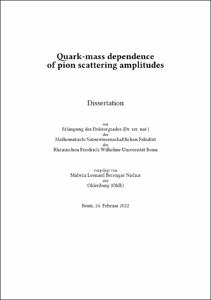Quark-mass dependence of pion scattering amplitudes

Quark-mass dependence of pion scattering amplitudes

| dc.contributor.advisor | Kubis, Bastian | |
| dc.contributor.author | Niehus, Malwin Leonard Berengar | |
| dc.date.accessioned | 2022-07-11T12:58:44Z | |
| dc.date.available | 2022-07-11T12:58:44Z | |
| dc.date.issued | 11.07.2022 | |
| dc.identifier.uri | https://hdl.handle.net/20.500.11811/10034 | |
| dc.description.abstract | We analyze lattice-QCD data of the ππ → ππ P wave obtained at unphysical-high pion masses with the inverse-amplitude method at next-to-leading order and at next-to-next-to-leading order. We then extrapolate to the physical pion mass and determine the properties of the ρ resonance from its pole in the complex plane. By comparing both orders, we estimate the systematic error associated with the truncation. Subsequently, we use the inverse-amplitude method as input to Khuri-Treiman equations for γ(*)π → ππ. The resulting dispersive framework is fit to lattice-QCD data at unphysical pion masses and then again extrapolated to the physical mass, where we determine the radiative coupling of the ρ, the lineshape, and the chiral anomaly of the process. Lastly, we develop a method to assess the statistics needed in experiments to be sensitive to higher-order pion rescattering in decays of a single particle into three pions and illustrate the approach for simple cases. | en |
| dc.language.iso | eng | |
| dc.rights | In Copyright | |
| dc.rights.uri | http://rightsstatements.org/vocab/InC/1.0/ | |
| dc.subject | Hadronenphysik | |
| dc.subject | Gitter QCD | |
| dc.subject | Dispersionsrelationen | |
| dc.subject | Anomalie | |
| dc.subject | Starke Wechselwirkung | |
| dc.subject | Chirale Störungstheorie | |
| dc.subject | Khuri-Treiman Gleichungen | |
| dc.subject | Inverse-Amplituden-Methode | |
| dc.subject | Rückstreuung | |
| dc.subject | Pionen | |
| dc.subject | hadron physics | |
| dc.subject | lattice QCD | |
| dc.subject | dispersion relations | |
| dc.subject | anomaly | |
| dc.subject | strong interaction | |
| dc.subject | chiral perturbation theory | |
| dc.subject | Khuri-Treiman equations | |
| dc.subject | inverse-amplitude method | |
| dc.subject | rescattering | |
| dc.subject | pions | |
| dc.subject.ddc | 530 Physik | |
| dc.title | Quark-mass dependence of pion scattering amplitudes | |
| dc.type | Dissertation oder Habilitation | |
| dc.publisher.name | Universitäts- und Landesbibliothek Bonn | |
| dc.publisher.location | Bonn | |
| dc.rights.accessRights | openAccess | |
| dc.identifier.urn | https://nbn-resolving.org/urn:nbn:de:hbz:5-67246 | |
| dc.relation.arxiv | 2110.05493 | |
| dc.relation.arxiv | 2110.11372 | |
| dc.relation.arxiv | 1902.10150 | |
| dc.relation.arxiv | 2009.04479 | |
| ulbbn.pubtype | Erstveröffentlichung | |
| ulbbnediss.affiliation.name | Rheinische Friedrich-Wilhelms-Universität Bonn | |
| ulbbnediss.affiliation.location | Bonn | |
| ulbbnediss.thesis.level | Dissertation | |
| ulbbnediss.dissID | 6724 | |
| ulbbnediss.date.accepted | 10.06.2022 | |
| ulbbnediss.institute | Mathematisch-Naturwissenschaftliche Fakultät : Fachgruppe Physik/Astronomie / Helmholtz-Institut für Strahlen- und Kernphysik (HISKP) | |
| ulbbnediss.fakultaet | Mathematisch-Naturwissenschaftliche Fakultät | |
| dc.contributor.coReferee | Urbach, Carsten | |
| ulbbnediss.contributor.orcid | https://orcid.org/0000-0002-5955-5380 | |
| ulbbnediss.contributor.gnd | 1267858397 |
Files in this item
This item appears in the following Collection(s)
-
E-Dissertationen (4373)




